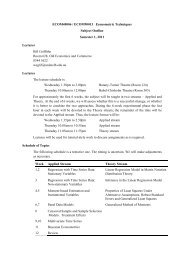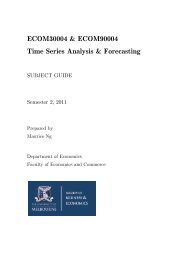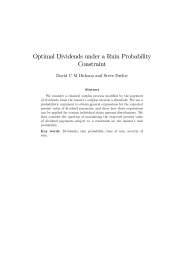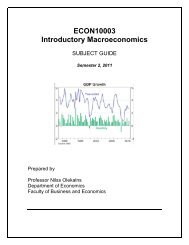A Model of Optimal Corporate Bailouts - Faculty of Business and ...
A Model of Optimal Corporate Bailouts - Faculty of Business and ...
A Model of Optimal Corporate Bailouts - Faculty of Business and ...
Create successful ePaper yourself
Turn your PDF publications into a flip-book with our unique Google optimized e-Paper software.
managers forced the firm into distress, it is plausible to assume that replacement managers arelikely to be at least as efficient as the original managers. 172.2.2 Case B: Intervention g ∗ = I 2 − R 2 /4·c Now consider the case where the government pays a positive bailout with g ∗ = I 2 − R 2 /4·c.As previously noted, a necessary (but not sufficient) condition for efficient intervention isπ ∗( 0, 0 ) = R 2 /(4·c) − I2 2 < 0, so that the firm would never restart the project in the absence<strong>of</strong> the bailout. We therefore confine our discussion below to that parametric case. Although thebailed-out firm reinvests, it earns zero continuation pr<strong>of</strong>its, so that π ∗( 2 g∗ , T ∗ ) = 0. In the case2<strong>of</strong> intervention, we must distinguish two subcases:1. The bailed-out firm restarts the project <strong>and</strong> fires the incumbent manager.2. The bailed-out firm restarts the project <strong>and</strong> retains the incumbent manager.Subcase 1: Bailed-Out Firm Restarts with Different Manager. When the incumbentmanager knows that she is fired upon a bailout, it is a one-period game for her. Given her wage,she maximizesM ≡ e 1·w 1 − c·e2 12 .Her optimal effort is e ∗ 1 ( w 1 ) = w 1 /c. The owners also expect to receive nothing at time 2, <strong>and</strong>set the wage to maximizeΠ| F G=FIRE= e ∗ ( w 1 1 )·(R − w 1 − T 1 ) + (1 − e ∗ 1 )·π∗( 2 g∗ , T ∗ ) .2} {{ }=0The firm’s pr<strong>of</strong>it-maximizing wage <strong>of</strong>fer is therefore w ∗ 1 = (R − T 1)/2. Compare this wage tothat in Section 2.2.1, where there was no government <strong>and</strong> the firm also fired the managerupon the restart. That expression, w ∗ 1 = I 2 + R /2 − R 2 / (8·c), showed that the continuationinvestment cost had a positive effect on the wage, while the manager’s moral hazard had anegative effect. If the government intervenes <strong>and</strong> the manager is also fired in such a restart,then the positive impact <strong>of</strong> the reinvestment cost (+I 2 ) is replaced with the negative impact<strong>of</strong> first-period taxation (−T 1 ). In addition, the moral-hazard term −R 2 /(8·c) term is missing.Thus, the incumbent manager may or may not be paid more at time 1 in the presence <strong>of</strong> agovernment than in its absence.Substituting the wage w ∗ 1 = (R − T 1)/2, the manager’s optimal effort level ise ∗ 1 = R − T 12·c,17 In the real world, if the manager is not fired, it could imply not just that the next-best alternative manager isworse, but that the manager has “captured” the firm’s board in the ? sense. If managerial capture causes the firmnot to fire the manager, then government intervention can add more value by firing the manager during a restartwith a government subsidy.17
















